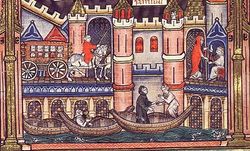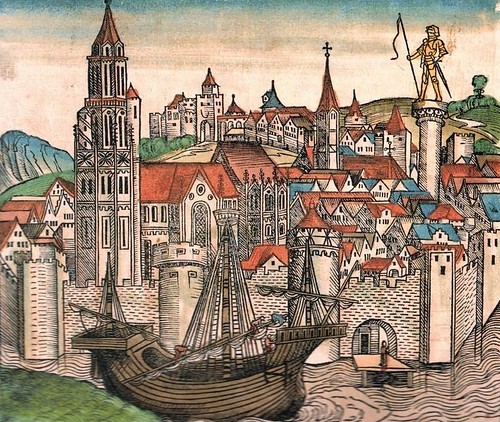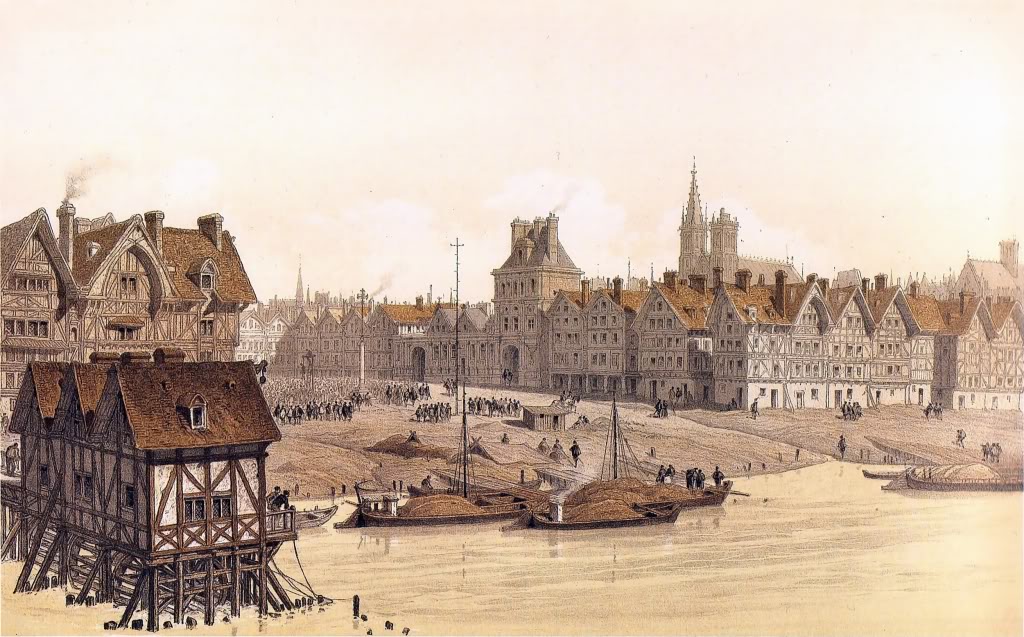'Queen of Cities' 1100-1300
Colin Jones, Paris: Biography of a City (New York: Viking, 2005), pp.32-37.
In the passages below Jones provides an overview of Paris around 1200. This can provide an overview of the explosive growth of the city in this period, but do not get lost in the details about each corner of the medieval city. Many of these places will become familiar to you as you get to know the city, and you might want to reread this passage later. But for now the goal is simply to get a sense of what the city was like in this period to help you place in context some of the places that we will be visiting on our intial tour.
[Paris] is situated at the heart of a delightful valley, in the midst of a crown of slopes enriched by both Ceres and Bacchus [the Roman gods of crops and wine]. The  Seine, this proud river which comes from the east, flows vigorously through it and encircles with its two arms the island which is the head, the heart, the very marrow of the whole city. Two faubourgs (or suburbs), the least of which would cause other cities envy, stretch out to right and left. Each communicates with the island by stone bridges: the Grand Pont is turned to the north, towards the English sea, while the Petit Pont looks towards the river Loire. The first faubourg, large, rich and full of business, is an effervescent theatre of activity; numerous boats, full of merchandise and wealth, surround it. The Petit Pont belongs to the dialecticians [medieval intellectuals], who walk about discussing grave matters.
Seine, this proud river which comes from the east, flows vigorously through it and encircles with its two arms the island which is the head, the heart, the very marrow of the whole city. Two faubourgs (or suburbs), the least of which would cause other cities envy, stretch out to right and left. Each communicates with the island by stone bridges: the Grand Pont is turned to the north, towards the English sea, while the Petit Pont looks towards the river Loire. The first faubourg, large, rich and full of business, is an effervescent theatre of activity; numerous boats, full of merchandise and wealth, surround it. The Petit Pont belongs to the dialecticians [medieval intellectuals], who walk about discussing grave matters.
This idealized description in 1175 by the minor writer Guy de Bazoches of 'the queen of cities', as Abbo had called it, highlighted important features of the city's transformation. Under the early Capetians, Paris had remade itself as a city of three parts, given cohesion by impressive stone bridges. The city had exploded outwards from the Ile de la Cite -- the 'heart' of the city, in which the foremost symbols of state power (the royal palace) and church authority (the cathedral) were located. The Right Bank had followed a commercial vocation, developing into a major business and trading centre. The Left Bank, heavily damaged by Viking assaults, developed a new role, associated with teaching and learning.
 The scale of these changes had turned a modest city of third-rank status into an urban centre to which, for the first time in its history, superlatives could be attached. This period marked the greatest quantum leap in the history of Paris, before and since. Not much more than a dot on the map even in 1100, by the end of the twelfth century it was the largest city in Christendom and a pre-eminent cultural and intellectual centre. Its economy was booming too -- indeed with Champagne, Flanders and Tuscany the Ile-de France was probably the wealthiest and most productive region in Europe. The city was also becoming -- in a meaningful and significant sense- -- a state capital, and indeed its emergence into prominence owed much to the influence and growing power of the Capetian dynasty established in such unpropitious circumstances in 987. The growth of the city mirrored the dynasty's successes, as the Capetian kings built up the initially tiny domains under their direct control into possessions which covered the majority of the feudal kingdom of 'France' (as 'West Francia' was now called) and which ranked among the most powerful states in Europe.
The scale of these changes had turned a modest city of third-rank status into an urban centre to which, for the first time in its history, superlatives could be attached. This period marked the greatest quantum leap in the history of Paris, before and since. Not much more than a dot on the map even in 1100, by the end of the twelfth century it was the largest city in Christendom and a pre-eminent cultural and intellectual centre. Its economy was booming too -- indeed with Champagne, Flanders and Tuscany the Ile-de France was probably the wealthiest and most productive region in Europe. The city was also becoming -- in a meaningful and significant sense- -- a state capital, and indeed its emergence into prominence owed much to the influence and growing power of the Capetian dynasty established in such unpropitious circumstances in 987. The growth of the city mirrored the dynasty's successes, as the Capetian kings built up the initially tiny domains under their direct control into possessions which covered the majority of the feudal kingdom of 'France' (as 'West Francia' was now called) and which ranked among the most powerful states in Europe.
Paris would turn out to be a considerable feather in the Capetians' hat. Yet the dynasty took some time to warm to it. Partly this was because there was little to warm to. Viking pillaging had removed much of the city's movable wealth, and caused untold damage to property outside the Cite stronghold. The houses and public buildings which were extant in 1100 were in most respects identical to those of the Carolingians [the dynasty that ruled France and a good deal of the rest of Europe from the 8th to the 10th centuries] and even the later Merovingians [the predecessors of the Caroligians]. Stone from the urban buildings of Antiquity had been pillaged over the centuries to provide the raw materials for fortifying the Cite, and the eminent sites of Lutetia were now passing out of Parisian memory. The amphitheatre had become a graveyard, while the old forum on the Montagne Sainte-Genevieve was widely believed by the thirteenth century to be the remains of Saracen buildings or a haunted chateau. Many of the Left Bank churches were still in ruins after the turn of the millennium. The erection of defensive earthworks on the Right Bank around the hillocks and churches of Saint-Merri and Saint-Gervais (IVe.) provided the basis for further development, but this too was slow to come. The city's population in 1100 may have been as little as 3,000. Yet by 1300 it was around 200,000. . . .
Relations between church and dynasty within Paris were all the more sensitive in that the Capetians were receptive to the growing role which ecclesiastical establishments had in repopulating the city, and developing its prosperity. This was particularly true of the Left Bank. The abbey of SaintGermain-des-Pres in particular built up in its environs an extensive dependent population of serfs who catered to the various agrarian and service requirements of the monks. It attracted new settlers on to its properties too, allowing them to establish a farmstead or a shop, in return for an annual rental payment, the cens. By the end of the thirteenth century the abbey had given the little bourg [village]its autonomy. The nearby parish church of SaintSulpice (Vle.) was built in 1211 to help accommodate the spiritual needs of a growing population, and at the same time two further parish churches (Saint-Andre-des-Arts and Saint-Côme) were added. Besides cultivating grain, many of the abbey's peasants devoted their land-holding to wine growing. The same tribute to Ceres and Bacchus -- in Guy de Bazoches's terms -- was also evident in lands owned by the canons of Sainte-Genevieve, which met Saint-Germain-des-Pres territory at around the level of the present-day Boulevard Saint-Michel. Vines flowed down the slopes of the hill to the very edge of the Seine: the Rue Galande (Ve.) memorializes the 'clos Garlande ', one of the biggest concentrations of vines.
The pattern of population development and economic growth was not dissimilar on the Right Bank. The creation of the parish church of Saint-Nicolas des-Champs (Ille.) close to the abbey-church of Saint-Martin -des-Champs highlighted the latter's success in attracting new population. To the south of the abbey was a sparser and more disreputable development of wanderers, minstrels and prostitutes in the ironically named 'Beau-Bourg' [“beautiful village”], which abutted on the church of Saint-Merri and the chapter of Sainte-Opportune. Slightly to their south-west was the Bourg Thibourg (or Tibourg), which was named after an eminent merchant: the Rue de la Tissanderie (or Tixanderie 'Weaver Street') became the core of an important area of textiles manufacture. Further to the west was a developing bourg around the church of Saint-Germain-l'Auxerrois, now recovered from being a Viking stronghold in the 88os (though it still retained a street structure based on that encampment) To the north-east were the extensive domains of the headquarters of the international crusading order, the Templars, based on a towering castle structure on the site of the present-day Square du Temple (IIle.). . . .

Paris Hotel de Ville (City Hall),